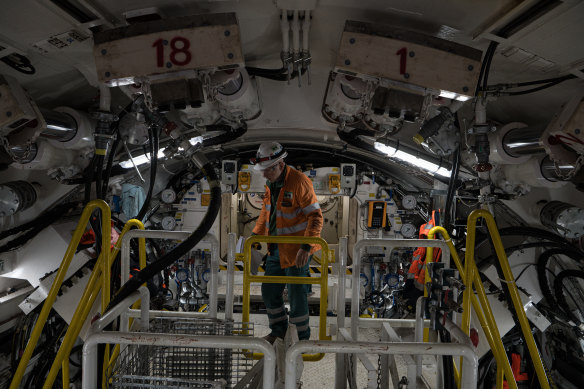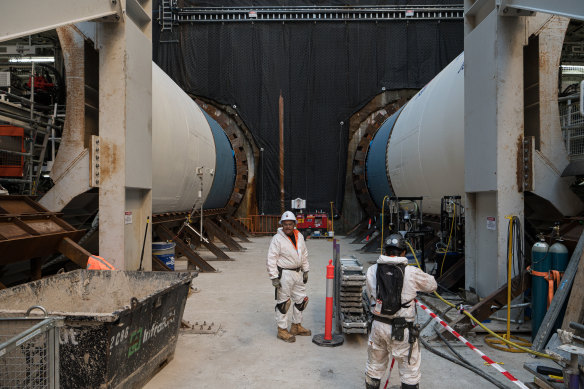This was published 11 months ago
Inside the giant worm set to carve out a second rail line under Sydney Harbour
Almost five years after a giant machine began tunnelling Sydney’s first rail line beneath the harbour, another massive borer is about to start churning through clay, sediment and rock to create the city’s second under-harbour crossing.
In an around-the-clock operation, the giant boring machine named Jessie has been launched on a 2.3-kilometre journey from the Bays precinct at Rozelle to the northern end of Sydney’s CBD after being assembled in a giant hole dug for a new metro train station there.
She will dig as deep as 26 metres beneath the harbour floor, worming her way alongside Anzac Bridge to a station site at Pyrmont before continuing under Darling Harbour to a cavern dug for a station beneath Hunter Street in the CBD.

A worker inside the massive boring machine that is about to start tunnelling under Sydney Harbour.Credit: Flavio Brancaleone
The 1100-tonne boring machine is specifically designed to excavate rock and sediment in high-pressure conditions under the harbour. She is named after Jessie Street, an Australian activist, feminist, and campaigner for women’s, Aboriginal, and Torres Strait Islander people’s rights.
With her trip under the harbour starting next week, Jessie is the fifth giant tunnelling machine to be launched for the $25 billion Metro West rail project, which will extend 24 kilometres from the CBD to Parramatta.
She will be followed later this year by another boring machine to complete the twin tunnels on the section of the new metro rail line between the Bays and CBD. The tunnels will extend under the Domain, passing beneath the heritage-listed State Library.
Transport Minister Jo Haylen said the metro rail tunnels from the Bays to the CBD were a “critical piece of the Metro West puzzle”, which would double rail capacity between CBD and Parramatta.
“At ultimate capacity, Sydney Metro West would be able to seamlessly move more than 40,000 people an hour in each direction through these new under-harbour tunnels,” she said.
Once Metro West opens to passengers in 2032, trains will run every four minutes in either direction.
Sydney Metro chief executive Peter Regan said it was more complex tunnelling under the harbour due to pressure from seawater above and softer soil conditions.

Workers in the huge hole dug at the Bays in Rozelle for a metro train station.Credit: Flavio Brancaleone
“They don’t move as fast, but think about where they are going under the water,” he said of the specialised boring machines excavating under the harbour.
Two boring machines have already travelled seven kilometres from the Bays precinct on their westwards journey to Sydney Olympic Park. Another two have covered more than three kilometres as they make their way eastwards from Rosehill, near Parramatta, to the Olympic precinct.
If an ambitious plan to redevelop Rosehill Racecourse and build an extra station for Metro West on the valuable site fails to be realised, journey times for passengers travelling on single-deck trains from Hunter Street in the CBD to Olympic Park will be 15 minutes and Parramatta 20 minutes. A trip under Darling Harbour to Pyrmont will take two minutes.
The tunnelling for Metro West comes as the second stage of Sydney’s driverless train network is due to open to passengers within the next few months.
The main section of the $21.6 billion Metro City and Southwest line extends from Chatswood in the north, under the harbour and CBD, to Sydenham in the south. The project comprises Sydney’s first rail crossing beneath the harbour between Blues Point and Barangaroo.
The opening date depends on the outcome of trial operations by Metro Trains Sydney, a private consortium led by Hong Kong’s MTR Corporation, which will run the line, and a final sign-off by the national rail safety regulator.
Premier Chris Minns said on Monday that the line was still due to open “in the middle of the year,” but he did not have an exact date because “it’s out of our hands.” He cited the need for independent safety auditors to approve operations.
Start the day with a summary of the day’s most important and interesting stories, analysis and insights. Sign up for our Morning Edition newsletter.